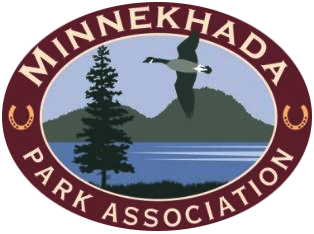Even at the height of the drought, the rainforest of Minnekhada Park always seems to retain this wet feeling. These wet conditions make the perfect environment for the growth of Moss, Lichen, and Fungi around the Park. Although wildlife sightings at Minnekhada are becoming less frequent as animals prepare for the winter conditions, it is still worth going to the Park and seeing the blossoming life of the moss, lichen, and fungi around the Park. With so many different species to see and identify, you can spend a whole afternoon searching for the different types of fungi, lichen, and/or moss at the Park. Once you start looking, you will see them everywhere and you will get hooked on looking for all the different types! I know I did! So next time you are at the Park take out your phone and open up your iNaturalist app and get ready to dive into the work of moss, lichen, and fungi.
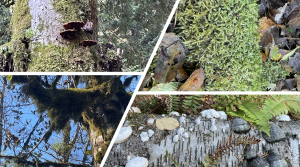
Although moss, lichen, and fungi are fundamentally different they are all similar in they tend to form symbiotic relationships (close relationships between two species) with other organisms and have a great ability to adapt and survive in extreme conditions. Now let’s take a closer look at each:
Moss
Mosses are among the first plants to survive the colonization of land when life started to transition out of the water. They are incredibly primitive plants that don’t have a vascular system (non-vascular plants). They are unique plants as they produce spores instead of seeds and have no roots. They inhabit places where many other plants cannot, such as tree stumps, sidewalks, buildings, etc. Being non-vascular plants means they cannot transport water very well, which is why they are so small in size. When you see a clump of moss, it is actually thousands of individual moss plants clumped together to better absorb and retain the water. You can see moss growing all around Minnekhada the wet conditions provide the perfect environment for moss to grow. You can see it growing on the trees, the bluffs, rocks, tree stumps, etc. Take a closer look next time you are at the park and see how many different types of moss you can see! Common moss species found around the park include Stairstep Moss, Lanky Moss, Badge Moss, Oregon Beaked Moss, and Douglas’ Neckera Moss, to name a few.
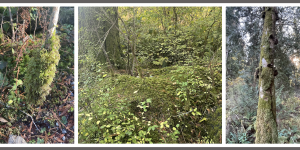
Lichen
Now lichen is very unique in that it is two organisms in one – algae and fungi – living in a symbiotic relationship. The outer portion of the lichen is the fungus which provides protection, support, and moisture from the air for the algae located inside the lichen. The algae in return, photosynthesizes for the lichen making food for itself and the fungus located on the outside. They must work together to grow and thrive. A common misconception of lichen is that it is harmful to live trees and plants, but that is not the case as they are self-sustaining. All the lichen needs are something to stick onto (rock, wall, tree, fence, etc.). Lichen is vital to the environment not just because it fixes nitrogen, but it also breaks down rocks to release minerals into the soil. As you walk around Minnekhada and look at the bluffs, you will see a common lichen called Maritime Reindeer Lichen. Although it is common in the Park, it is easily disturbed. Anytime we are off trail for our invasive species removals we are extra careful not to disturb it! Other common species of lichen found in the Park include the Varied Rag Lichen, Common Script Lichen, Shield Lichen, and Green Loop Lichen. See which ones you can find and see if you can tell them apart from the moss!
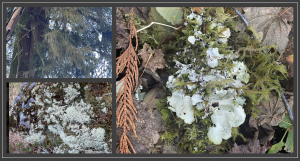
Fungi
Now not to be biased, but going to look for Fungi in Minnekhada has to be a favorite pastime during the rainy months. With so many different species of fungi around the world (as many as 3.8 million species and 90% of them still needing to be identified), it never gets boring going to see the mass variety found at Minnekhada! Although, fungi may look closely related to plants, recent evidence suggests that they are more closely related to animals than plants. Fungus cannot photosynthesize, meaning they have to get their food from an outside source – they absorb nutrients from other organic substances. Most fungi -aside from yeast- grow thread-like filaments called hyphae. A mass of hyphae makes up the body of the fungi called mycelium. As mentioned above, there are many different fungi around the world. Most people commonly think of mushrooms when thinking of fungus, but there is a large variety to explore.It is an adventure going out to Minnkehada to find the different fungi from the more typically mushroom-shaped ones to the more oyster/clam-shaped ones. There is a lot to see. Some fungi you can find at the park include Hoof Fungus, American Brown Fomitopsis, Turkey-Tai, Witch’s Butter, and Common Milkcaps. Can you find more?
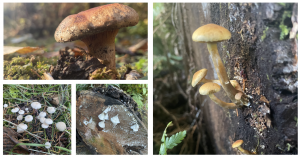
As you can see, there is still plenty of reason to go out and visit Minnekhada park. Make an afternoon of fungi/lichen/moss hunting. Take the entire family and see how many different species you can see. Make it a scavenger hunt or a some sort of game. Make sure to download iNaturalist before you go, so you can start to identify all different species you see in the park. As always, please refrain from picking any of the fungi, moss or lichen. We want to make sure the next visitors are able to enjoy the park as you have!




